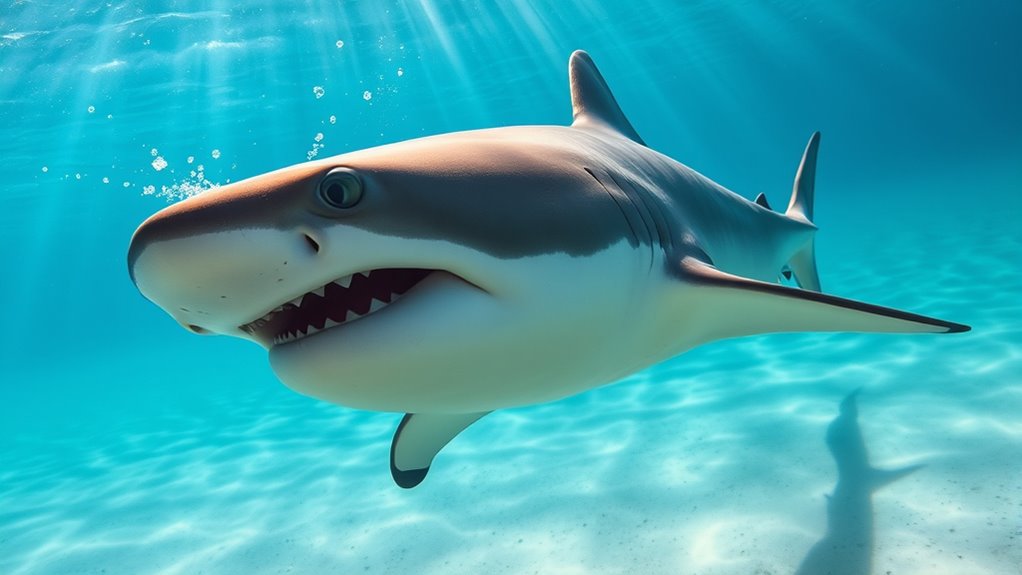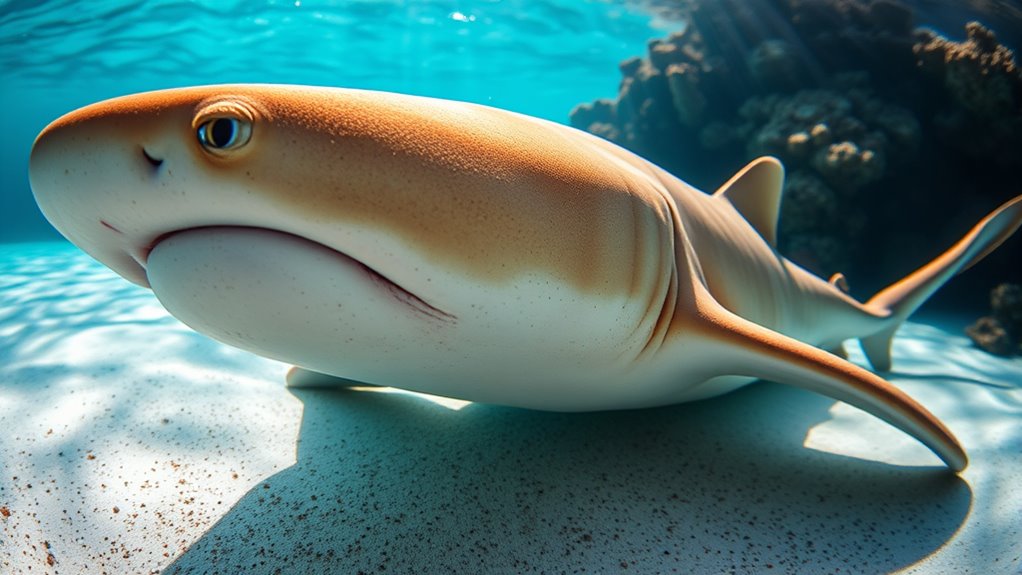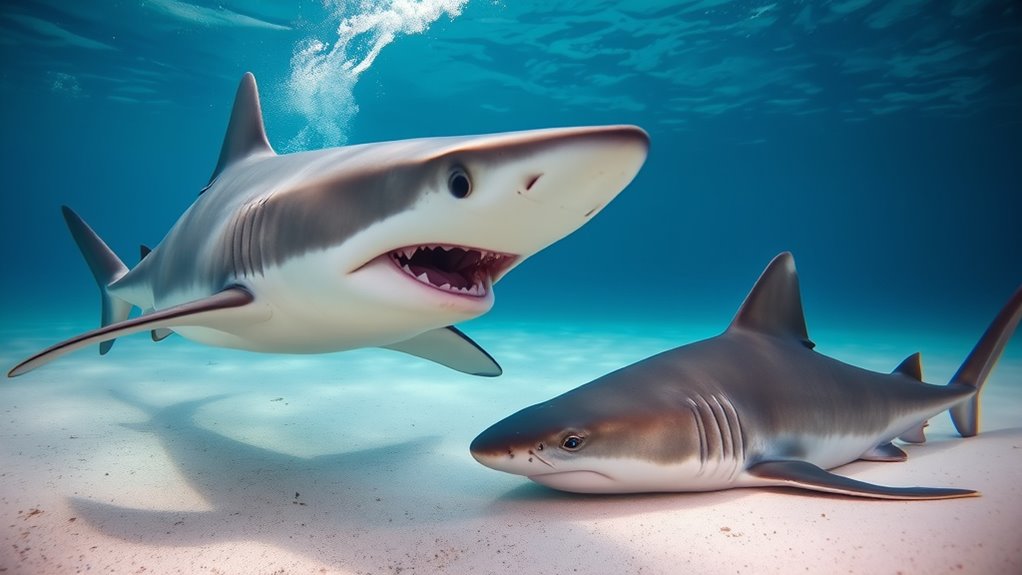No, not all sharks die when they stop swimming. Only obligate ram ventilators like great whites and makos must swim continuously to breathe. Many shark species, including nurse sharks and wobbegongs, use buccal pumping—actively drawing water over their gills while stationary. Some sharks even employ both techniques, switching between methods depending on their activity level. These diverse respiratory adaptations reflect millions of years of evolution customized to each species’ ecological niche and lifestyle requirements.
The Swimming-Breathing Connection in Sharks

While most fish extract oxygen through a process called buccal pumping, many shark species rely on a method known as ram ventilation to breathe. This technique requires forward movement to force water through their gills, creating a direct link between swimming mechanics and respiratory efficiency.
As you examine shark physiology, you’ll notice their gill structure lacks the specialized muscles found in bony fish. Instead, when sharks swim, water naturally flows over their gills as they move forward, facilitating oxygen extraction. This adaptation optimizes energy usage during constant swimming.
However, not all sharks depend exclusively on ram ventilation. Species like nurse sharks and wobbegongs have developed specialized muscles that allow them to pump water across their gills while stationary, enabling them to rest on the ocean floor without suffocating.
Ram Ventilation vs. Buccal Pumping: Two Breathing Strategies
Sharks employ two distinct respiratory methods: ram ventilation, where swimming forces water over the gills, and buccal pumping, where specialized muscles draw water in while stationary. You’ll find that certain species like reef sharks exclusively use buccal pumping, while pelagic hunters like great whites primarily rely on ram ventilation for oxygen delivery. These respiratory adaptations directly impact energy expenditure, with ram ventilators requiring constant swimming that consumes more energy, while buccal pumpers conserve energy through their ability to rest on the ocean floor.
Oxygen Delivery Methods
Unlike mammals that exclusively use lungs to breathe, sharks have evolved two distinct methods for extracting oxygen from water: ram ventilation and buccal pumping. These mechanisms represent adaptations for efficient oxygen transport and ideal gill function across diverse shark species.
- Ram ventilation – Forward swimming forces water through the mouth and over the gills, enabling oxygen extraction without muscular effort
- Buccal pumping – Specialized throat muscles actively draw water into the mouth and push it across gill surfaces
- Mixed-mode respiration – Some species can switch between both methods depending on activity level or environmental conditions
- Gill structure – Five to seven gill slits contain filaments with lamellae where dissolved oxygen diffuses into blood vessels
You’ll find obligate ram ventilators like great whites must swim continuously, while buccal pumpers like nurse sharks can rest on the seafloor.
Species-Specific Adaptations
Throughout the evolutionary history of sharks, distinct respiratory adaptations have emerged that directly correlate with each species’ lifestyle, habitat preferences, and hunting strategies.
You’ll find obligate ram ventilators like great whites and makos that must swim continuously to breathe, reflecting their pelagic, predatory ecological niches. Their streamlined bodies and constant motion align perfectly with their hunting behaviors. Conversely, species like nurse sharks and wobbegongs have evolved efficient buccal pumping mechanisms, allowing them to remain motionless on the seafloor for extended periods while actively drawing water over their gills.
Many sharks, including reef sharks and bull sharks, possess dual-mode respiration, switching between ram ventilation while swimming and buccal pumping when resting. These adaptive breathing strategies directly influence species behaviors and determine how different sharks occupy their specialized ecological niches.
Energy Conservation Differences
The two primary respiratory mechanisms in sharks—ram ventilation and buccal pumping—involve dramatically different energy expenditures, creating trade-offs that have shaped evolutionary adaptations across species.
Energy efficiency varies substantially between these respiratory strategies:
- Ram ventilation requires continuous swimming, consuming approximately 20-30% more energy than buccal pumping but delivering higher oxygen absorption rates.
- Buccal pumping allows for rest periods, reducing total metabolic rates during inactive phases by up to 25%.
- Obligate ram ventilators (like makos) maintain higher baseline metabolic rates, necessitating constant hunting and feeding.
- Facultative species can switch between methods, optimizing energy expenditure based on environmental conditions and hunting requirements.
You’ll notice these differences directly impact hunting strategies, migration patterns, and habitat selection—ultimately determining how each species balances the energy costs of respiration against other survival needs.
Obligate Ram Ventilators: Sharks That Must Keep Moving
While many fish can actively pump water over their gills while stationary, certain shark species have evolved as obligate ram ventilators, requiring continuous forward movement to breathe. These obligate species, including great whites, makos, and most oceanic sharks, lack the specialized muscles to pump water across their gill surfaces when immobile.
Their respiratory adaptations rely on forward motion to force oxygen-rich water through their open mouths and over their gills—a process called ram ventilation. You’ll notice these sharks rarely stop swimming; they’ve developed this perpetual motion lifestyle as an evolutionary trade-off for speed and oceanic hunting efficiency.
Without forward movement, oxygen levels in their bloodstream would rapidly deplete, leading to suffocation. This explains why these species must keep swimming to survive, even during rest periods through slow, controlled swimming patterns.
Restful Reef Dwellers: Sharks That Can Remain Still

In contrast to their constantly swimming cousins, many shark species possess the ability to remain completely motionless. These sharks have evolved specialized resting strategies that allow them to extract oxygen while stationary. You’ll find these restful reef dwellers employing buccal pumping—actively drawing water over their gills while remaining still.
Key stationary behaviors include:
- Bottom-resting, where species like nurse sharks lie directly on sandy substrates
- Cave-sheltering, commonly observed in whitetip reef sharks during daylight hours
- Vertical hovering, practiced by Caribbean reef sharks in strong currents
- Intermittent swimming, where wobbegongs alternate between brief movements and prolonged stillness
These adaptations demonstrate evolutionary divergence in respiratory mechanisms, allowing these species to conserve energy while maintaining adequate oxygenation—a physiological advantage in their ecological niches.
The Science Behind Shark Respiration
Understanding shark respiration requires examining the fundamental biological mechanisms that enable these marine predators to extract dissolved oxygen from their aquatic environment. Sharks utilize two primary respiratory methods: ram ventilation and buccal pumping.
In ram ventilation, sharks force water over their gills by swimming forward with their mouths open. This continuous forward motion creates water pressure that pushes oxygen-rich water across their gill filaments. The shark’s specialized gill anatomy features thin membranes where gas exchange occurs.
Alternatively, buccal pumping involves the shark’s respiratory muscles actively drawing water into the mouth and forcing it over the gills. This respiratory mechanics allows some species to remain stationary. The efficiency of oxygen extraction depends on the surface area of gill filaments and the countercurrent exchange system where blood flows opposite to water direction.
Evolutionary Adaptations for Different Lifestyles

Sharks have evolved diverse respiratory strategies over millions of years to match their specific ecological niches and energy requirements. These lifestyle adaptations reflect the evolutionary pressures faced by different species in their respective environments.
- Obligate ram ventilators – Fast-swimming pelagic sharks like makos and great whites evolved continuous swimming behavior to maintain oxygen flow across their gills
- Buccal pumping specialists – Bottom-dwelling species developed powerful throat muscles to actively push water through their respiratory system while stationary
- Facultative ventilators – Versatile species like nurse sharks acquired both mechanisms, allowing them to switch between active swimming and resting states
- Spiracle development – Some species evolved specialized openings behind their eyes to draw in oxygenated water while remaining motionless on the seafloor
Myth vs. Reality: What Happens When Various Sharks Stop Swimming
The distinction between obligate ram ventilators (sharks that must swim continuously to breathe) and buccal pumpers (those capable of actively moving water across their gills while stationary) determines whether stopping movement is fatal. You’ll find species-specific variations, with oceanic sharks like great whites and makos typically requiring constant movement, while reef sharks, nurse sharks, and wobbegongs can rest on the seafloor for extended periods. When resting, many shark species exhibit specialized behaviors such as lying motionless in caves or currents that push oxygenated water over their gills, allowing them to conserve energy while maintaining respiratory function.
Obligate vs. Ram Ventilators
Contrary to popular belief, not all sharks will die if they stop swimming. Shark species are classified by their breathing mechanisms: obligate swimmers and buccal pumpers.
Obligate swimmers use ram ventilation, requiring constant movement to force water through their gills. In contrast, buccal pumpers can actively draw water over their gills while stationary.
- Great white sharks, makos, and whale sharks are obligate swimmers that must maintain movement for oxygen
- Nurse sharks, carpet sharks, and wobbegongs can rest on the seafloor using buccal pumping
- Some species like the Caribbean reef shark utilize both methods depending on circumstances
- Tiger sharks primarily use ram ventilation while swimming but can switch to buccal pumping briefly
The relationship between a shark’s ventilation method and mobility requirements demonstrates evolutionary adaptations to specific ecological niches and hunting strategies.
Species-Specific Swimming Requirements
Different shark species face varying consequences when they cease swimming, often contrary to the widespread notion that all sharks suffocate when immobile. Great whites and whale sharks, true ram ventilators, require constant movement to breathe, while reef sharks and nurse sharks can pump water over their gills while stationary.
You’ll find that swimming adaptations correlate strongly with habitat preferences. Open-ocean sharks with pelagic lifestyles typically depend on forward motion for respiration, making them true obligate swimmers. In contrast, bottom-dwelling species that navigate complex reef structures have evolved buccal pumping mechanisms that allow them to rest on the seafloor without respiratory distress.
These physiological differences explain why you might observe a nurse shark resting in a cave, while you’d never witness a mako shark in a similar stationary position.
Resting Shark Behaviors
Despite popular misconceptions, resting shark behaviors vary dramatically across species, revealing complex respiratory adaptations rather than a universal requirement for constant swimming. When you observe shark sleep and behavior patterns, you’ll notice distinctive resting strategies evolved to maintain oxygen flow while conserving energy.
These behaviors include:
- Buccal pumping – Many reef sharks actively pump water over their gills while lying motionless on the seafloor.
- Vertical resting – Some species like Caribbean reef sharks hover vertically in caves with minimal movement.
- Current exploitation – Reef sharks position themselves strategically in currents that naturally force water through their gill systems.
- Reduced metabolism – During rest periods, certain species enter states of reduced activity where oxygen requirements decrease greatly.
These adaptations enable sharks to rest effectively without compromising respiratory function, contradicting the myth that all sharks die when immobile.
Notable Exceptions to the Swimming Rule
While many shark species must swim continuously to breathe, several notable exceptions exist within the shark family that have evolved alternative respiratory methods. You’ll find these species have developed specialized swimming adaptations that allow them to rest without risking suffocation.
| Species | Respiratory Mechanism | Resting Behavior |
|---|---|---|
| Nurse Shark | Buccal pumping | Lies on seafloor |
| Whitetip Reef Shark | Buccal pumping | Rests in caves |
| Wobbegong | Spiracles | Remains motionless |
| Bamboo Shark | Spiracles + pumping | Hides under rocks |
| Angel Shark | Large pharynx | Buries in sand |
These exceptions demonstrate remarkable evolutionary divergence in shark behavior. Species with buccal pumping can actively draw water over their gills while stationary, while others utilize enlarged spiracles to pull oxygenated water directly into their respiratory systems. This physiological adaptation enables these sharks to conserve energy while maintaining essential oxygen intake.
How Different Ocean Environments Shape Shark Behavior
The ocean’s distinct environments profoundly influence shark swimming patterns and respiratory behaviors across species. When you study shark adaptations across different habitats, you’ll find remarkable specialization based on environmental conditions.
- Temperature gradients: Cold-water sharks typically swim continuously to generate body heat, while tropical species may rest more frequently in warm currents.
- Depth variations: Deep-sea sharks encounter less oxygen availability, developing specialized gill structures that extract oxygen more efficiently than their shallow-water relatives.
- Ocean currents: Strong-current environments have produced sharks with more streamlined bodies and improved swimming efficiency.
- Habitat diversity: Reef-dwelling sharks often utilize caves or crevices for stationary rest periods, whereas open-ocean species remain in constant motion to maintain their position against prevailing currents.
Conservation Implications of Shark Mobility Requirements
The diverse rest requirements among shark species should inform how you design marine sanctuaries, particularly regarding size and habitat connectivity for both obligate and facultative ram ventilators. You’ll find that conservation strategies must account for species-specific mobility needs, with stationary species requiring different protections than constantly swimming ones. Commercial fishing methods like longlines and gill nets disproportionately threaten obligate swimmers who cannot rest during entanglement, highlighting the need for fishing gear modifications and time-area closures in critical shark habitats.
Species-Specific Rest Needs
Due to significant variations in respiratory adaptations across shark species, conservation efforts must account for these diverse mobility requirements when designing protective measures. Species adaptations range from obligate ram ventilators like great whites to buccal pumping specialists such as nurse sharks. These behavioral variations directly influence how different sharks rest and recover.
When developing conservation strategies, you’ll need to take into account:
- Habitat protection – Providing adequate resting zones for bottom-dwelling species
- Migration corridors – Ensuring unobstructed pathways for constantly swimming species
- Oxygen requirements – Accounting for species-specific respiratory thresholds
- Energetic constraints – Recognizing metabolic differences between active and sedentary species
Understanding these distinct rest requirements helps tailor protection efforts to specific shark populations rather than applying one-size-fits-all approaches that might prove ineffective for certain species.
Marine Sanctuary Design
Effective marine sanctuary design hinges on incorporating sharks’ mobility requirements into protection frameworks. You’ll find that sanctuaries must account for both obligate ram ventilators and buccal pumpers when establishing protected zones. For species like oceanic whitetips and great whites, sanctuaries need corridors spanning hundreds of kilometers to accommodate their continuous swimming patterns.
Marine habitat design should include multiple rest habitats for buccal pumping species while guaranteeing sufficient area for obligate swimmers’ constant movement. Research indicates that sanctuary effectiveness increases when boundaries align with natural swimming patterns rather than arbitrary geographical markers. Protected areas must also incorporate seasonal migration routes, feeding grounds, and breeding sites to fully safeguard shark populations. This integrated approach guarantees that conservation efforts address the physiological needs of different shark species while maximizing protection against anthropogenic threats.
Fishing Method Impacts
Commercial fishing methods greatly impact shark populations by exploiting their specific mobility requirements and respiratory adaptations. When you examine fishing gear interactions with different shark species, you’ll find varying vulnerability patterns based on their respiration mechanisms.
- Longlines disproportionately affect ram ventilators (constant swimmers) who become hooked and cannot maintain water flow across their gills.
- Gill nets capture both ram and buccal ventilators, but ram-dependent species experience higher mortality rates.
- Trawling operations create lethal scenarios for obligate swimmers captured in nets for extended periods.
- Circle hooks reduce shark bycatch mortality by 28% compared to J-hooks by allowing better release viability.
These impacts necessitate fishing regulations designed to protect species with strict mobility requirements, especially ram ventilators who cannot survive prolonged restraint in fishing gear.
Frequently Asked Questions
Can Sharks Swim Backward When Necessary?
You’ll find that sharks can’t swim backward due to their unique shark anatomy. Their pectoral fins lack the mobility required for reverse motion. Shark swimming mechanics depend on forward thrust generated by lateral tail movements, which propels them only forward through water. Their rigid pectoral fins provide lift and steering but can’t create backward propulsion. This anatomical limitation means sharks must constantly move forward, turning in circles when needed to navigate away from obstacles.
Do Baby Sharks Have Different Breathing Requirements Than Adults?
Baby sharks do have different breathing requirements than adults across developmental stages. You’ll find that most shark pups possess external gill filaments before birth, providing improved oxygen absorption while developing in low-oxygen environments. As they mature, these temporary breathing mechanisms recede, and their respiratory systems change to adult function. The efficiency of their buccal pumping (ability to push water over gills while stationary) is typically stronger in juveniles, gradually moving in the direction of more ram ventilation dependence as they grow.
How Long Can an Average Shark Survive Out of Water?
You’ll find that an average shark’s survival time out of water is extremely limited, typically between 4-10 minutes. This brief window relates directly to their oxygen requirements and respiratory system design. Without water flowing over their gills, sharks cannot extract oxygen, leading to rapid suffocation. Larger species may survive slightly longer due to greater oxygen reserves in their tissues, while smaller sharks deplete their reserves more quickly.
Can Sharks Choke or Drown if They Swim Through Polluted Water?
Yes, sharks can choke or drown in polluted water. Their respiratory system relies on efficient oxygen extraction as water passes over their gills. In polluted ecosystems, contaminants like oil, chemicals, and microplastics can coat gill filaments, reducing oxygen uptake and causing respiratory distress. You’ll find that particulate matter can physically obstruct gill structures, while toxins may damage delicate gill tissues. Some pollution types decrease available dissolved oxygen, further compromising sharks’ breathing capacity in compromised environments.
Do Sharks Ever Sleep With Their Eyes Closed?
Sharks don’t sleep with their eyes closed like you do. Their sleep patterns involve periods of reduced activity called “rest phases” where they remain alert but less active. Most shark species lack eyelids entirely, while others have a nictitating membrane that can partially cover the eye. During these rest phases, shark behavior maintains vigilance against predators and opportunities for feeding. This evolutionary adaptation guarantees continuous water flow over their gills while allowing their brain to rest selectively.



